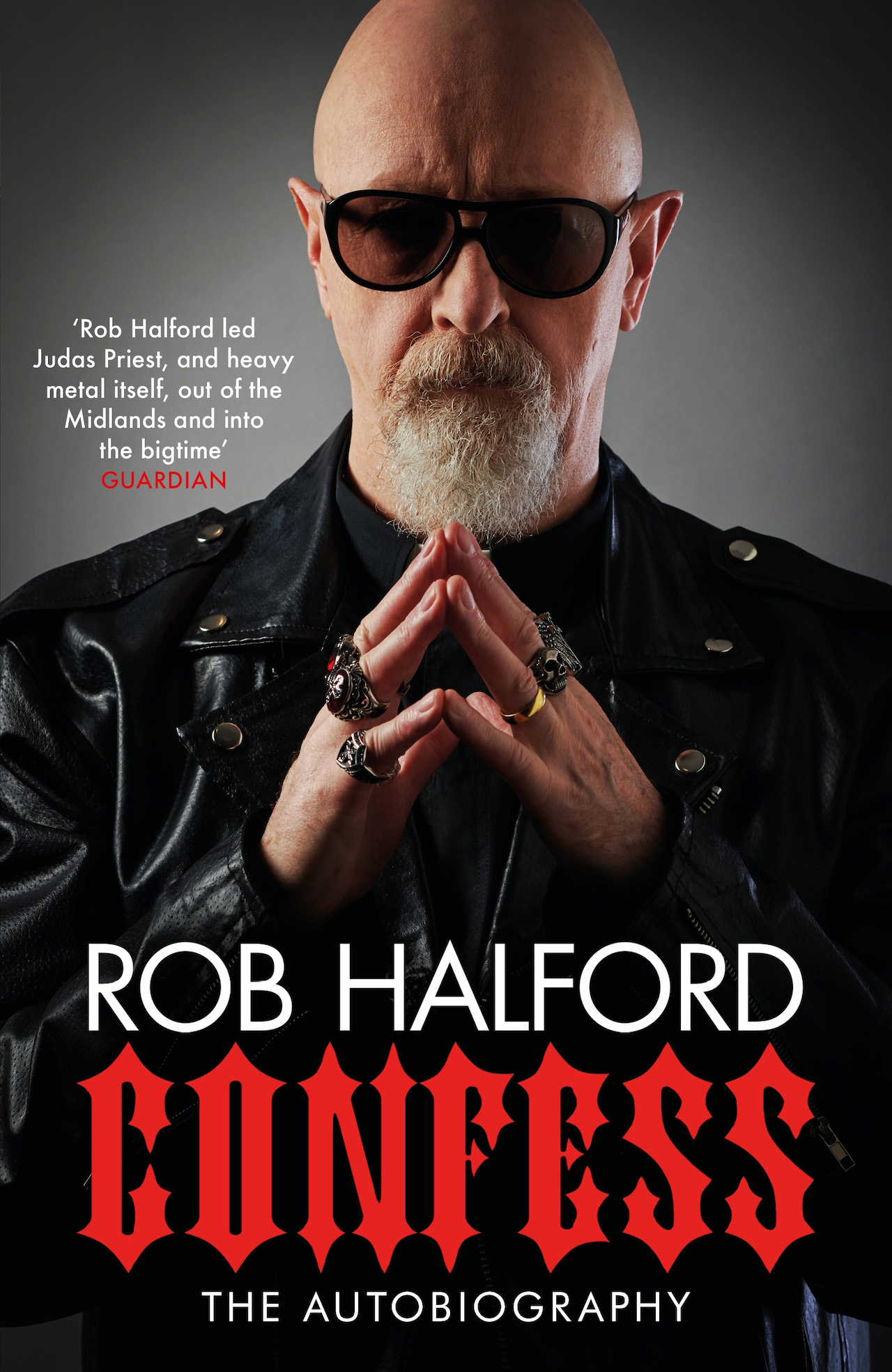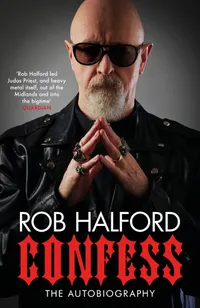Rob Halford: “If I wanted some action on the road, how the hell was I supposed to go about it?”
In this exclusive extract from his upcoming autobiography Confess, Rob Halford looks back on Judas Priest’s transformation into leather-clad metal gods - and why he stayed in the closet for so long

When you wake up from a vivid, vibrant dream, dull reality can feel seriously deflating. Touring America had been like living a fever dream – or, if I am honest, a wet dream! When I got back home, for a few days I hit a major slump.
After weeks of traversing the States, running wide-eyed around the fleshpots of Times Square and jumping around for 80,000 Zep fans, I couldn’t help but feel flat when I was waiting in the piddling rain to get the bus to the Dirty Duck. I’d been out and seen the world, and the Yew Tree Estate in Walsall suddenly felt very small.
Coming off tour can be such a comedown. One minute you are wowing crowds, signing autographs and being interviewed on the radio. The next, you are trudging to the corner shop and coming back to be told off by your housemates for forgetting the Rizlas.
You feel like you want to tell people everything you have done, but they don’t always want to hear it. ‘How was America, Rob?’ a mate would ask me down the Duck.
‘Oh, God, amazing!’ I’d say. ‘New York was incredible, and St Louis, and Robert Plant is such a great guy…’
‘Oh, yer? Sounds great!’ they’d say. ‘I’m tekkin’ the motor in for its MOT tomorrow…’
I was young, and precocious, and it was frustrating – but now I’m older, I can see that that downbeat, matter-of-fact Black Country nature, that deadpan refusal to blow smoke up anyone’s arse, has been a blessing for me. Because, without it, I might have turned into a right dickhead.
Sign up below to get the latest from Metal Hammer, plus exclusive special offers, direct to your inbox!
- The best Metallica merch 2020: amazing gifts for the Metallica fan in your life
- Less noise, more rock with the best budget noise cancelling headphones
- Best music streaming services: how do Spotify, TIDAL, Apple Music and others compare?
- Loudest Bluetooth speakers: the best speakers for maximum noise
But I didn’t have too much time to feel sorry for myself – because Priest had another album to make. CBS gave us a new producer for the album that was to become Stained Class: Dennis Mackay, who had an eclectic CV that included producing Curved Air, Gong and Tommy Bolin. We began work at the live-in Chipping Norton Recording Studios in the Cotswolds.
Those sessions were the first time I became aware of tensions within our twin-guitar attack of Glenn [Tipton] and Ken [KK Downing]. They normally rubbed along OK, on the surface at least, but there was no denying that they were very different characters.
Glenn was – and always has been – a very confident, assured, driven individual. He knows what he wants to do and how he wants to do it. From the start, he had a very strong vision for how he wanted the band to sound, and that was coming to the fore on Stained Class.
He and I wrote the title track to the album and Exciter, and he wrote White Heat, Red Hot on his own. Yet probably my favourite track on the album was penned by me and Les Binks.
Les had settled in well as Priest’s drummer, and he and I wrote Beyond the Realms Of Death (that Roget’s Thesaurus was worth its weight in gold!) together. It was a song about a protagonist who was struggling through the world, at the end of his tether. It had some very personal lines:
“I’m safe here in my mind
I’m free to speak with my own kind
With my own kind.”
Because, in 1978, the idea of being able to talk to other gay men, openly, freely and without stigma, seemed as likely as pole-vaulting to Mars. I just knew: It will never bloody happen.

Dennis Mackay did a good job on the album. We were still prone to prog-rock noodling, and he saw our songs could go on a bit. He pointed out that we didn’t have to make a musical statement, then keep repeating it. Shear off the waste! Hit people with the sharp end!
CBS were keen to include a track that might pick up serious play on American rock radio, and suggested a cover of Spooky Tooth’s Better By You, Better Than Me. It was a last-minute addition to the album at the mixing stage, and James Guthrie, who came recommended by CBS, produced it, as Dennis Mackay was unavailable.
Released early in ’78, Stained Class was well received and within two months of recording it, we were back on tour. The venues went up a notch again – Hello, Hammersmith Odeon! Good evening, Birmingham Odeon! – and something else had notably changed.
As Priest began to get bigger, and our tracks got more airplay, the make-up of our crowds was beginning to change. The rabid, headbanging blokes that were our core following were as loyal as ever, but we also started to get more women followers… and our first groupies.
Well, I didn’t. None of our fans knew that I was gay at this point, of course. If any misguided girls made a play for me, I could politely brush them off. But if I wanted some action on the road – and I really, really did – how the hell was I supposed to go about it?
For straight blokes, the ritual was easy. They could invite a girl to come backstage. Would you like a drink? Would you like to come to our hotel? Would you like to see my room?
I couldn’t do any of that. If I fancied a guy in the crowd, how did I go about it? What were the chances of him being gay (or, if he was, of admitting it)? What if I got it wrong, made a misjudged pass and got a smack in the mouth? And, of course, the overriding fear that was to limit my existence for decades:
What if it got out that I was gay, fans didn’t want anything to do with a band fronted by a queer, and it killed Judas Priest stone dead?
Priest was the most important thing in my life, and even if I were willing to sacrifice it for my sexuality – which I wasn’t – I simply couldn’t do it to Ken, or Glenn, or Ian. It wouldn’t be fair on them.
It was my problem, not theirs.
No, the safest thing, the only thing, to do was to remain firmly in the closet. And that meant our fans were off limits.
The other main change in Priest-world during the course of 1978 was the complete and total revamp of our image. Ken had the idea, and I quickly bought into it. He and I went down to London and got fitted for bespoke leather outfits. Ken reckons as soon as the guy took my inside leg, I was up for it, but I like to think I’m not quite that cheap.
Not quite.
When we got back to Walsall and showed the others our new black leather cut-off shirts and trousers, they were all into the idea. So, we all trekked down to London again to order the gear.
Some of the outfitters we visited were hilarious. One place in Soho was run by a tall, very camp, middle-aged queen with long hair and a Guy Fawkes-like goatee beard. Every time we went into his shop, he would pirouette and clap his hands with excitement.
‘Yay! Here they are, my boys!’ he’d squeal. His party piece was doing an impressive Tiller Girls kick – his foot would go way up over his head. ‘Not bad for a man of fifty-eight, eh, boys?’ he’d ask us. I had to give it to him, he was very flexible… and quite possibly double-jointed.
Suzi Watkins, a Canadian who worked at Arnakata, took us to an S&M and fetish shop in Wandsworth. As well as leather trousers, caps, boots and wristbands, it had cock rings, chains and whips!
I thought that one or two of the Priest lads looked a little uncomfortable in there.

Our leather-and-studs image came together gradually over the next few weeks and felt very natural. I thought we were channelling all sorts of things, from macho culture to Marlon Brando, but the end result was that suddenly we looked like a heavy metal band.
The biggest myth about this new stage gear is that I had somehow masterminded the image as a cover and a vent for my homosexuality – that I was getting a thrill from dressing on stage as I’d like to dress in the street, or the bedroom. This is utter bollocks.
I had no interest in S&M, domination or the whole queer subcult of leather and chains. It just didn’t do it for me. My sexual preference was for men, sure, but I was – and still am – pretty vanilla. I’ve never used a whip in the boudoir in my life.
Or, have I? Hang on, let me think for a minute…
Les was the slowest to fall into line with our new look. He didn’t seem to have got the memo. We would turn up for photo shoots with Ken, Glenn, Ian and I clad head to toe in leather, and Les would be grinning away in jeans and a scruffy cowboy shirt.
It did my head in: Les! We’re trying to get an image together here! But I never knew how to broach the topic with him. At least he’s hidden behind the drums, I thought. Eventually, he half-heartedly fell into line and bought himself a biker jacket. Our fans, male and female, certainly didn’t detect any secret, cryptic gay element to our new image. They just thought we looked macho, and butch, and alpha male. Imitation outfits started springing up in our crowds, a sure sign that the look was a success.
I must admit, I still occasionally look back at Priest photos of that late seventies era, and suspect that they were our Shirley Bassey leather years. But that is probably just me being me.
Extracted from ‘Confess: The Autobiography’ by Rob Halford published by Headline on 29th September.

Rob Halford: Confess
In his new autobiography Confess, Judas Priest frontman Rob Halford charts his five decades in the music industry, with the book described as “a celebration of the fire and power of heavy metal.”


